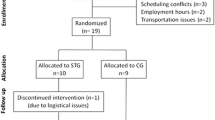Abstract
The aim of this study was to compare the effects of a weight training program for the leg extensors with isokinetic cycling training (80 rpm) on maximal power output and endurance performance. Both strength training interventions were incorporated twice a week in a similar endurance training program of 12 weeks. Eighteen trained male cyclists (VO2peak 60 ± 1 ml kg−1 min−1) were grouped into the weight training (WT n = 9) or the isokinetic training group (IT n = 9) matched for training background and sprint power (P max), assessed from five maximal sprints (5 s) on an isokinetic bicycle ergometer at cadences between 40 and 120 rpm. Crank torque was measured (1 kHz) to determine the torque distribution during pedaling. Endurance performance was evaluated by measuring power, heart rate and lactate during a graded exercise test to exhaustion and a 30-min performance test. All tests were performed on subjects’ individual race bicycle. Knee extension torque was evaluated isometrically at 115° knee angle and dynamically at 200° s−1 using an isokinetic dynamometer. P max at 40 rpm increased in both the groups (~15%; P < 0.05). At 120 rpm, no improvement of P max was found in the IT training group, which was possibly related to an observed change in crank torque at high cadences (P < 0.05). Both groups improved their power output in the 30-min performance test (P < 0.05). Isometric knee extension torque increased only in WT (P < 0.05). In conclusion, at low cadences, P max improved in both training groups. However, in the IT training group, a disturbed pedaling technique compromises an improvement of P max at high cadences.





Similar content being viewed by others
References
Bastiaans JJ, van Diemen ABJP, Veneberg T, Jeukendrup AE (2001) The effects of replacing a portion of endurance training by explosive strength training in trained cyclists. Eur J Appl Physiol 86(1):79–84
Behm DG, Sale DG (1993) Velocity specificity of resistance training. Sports Med 15(6):374–388
Bell GJ, Wenger HA (1992) Physiological adaptations to velocity controlled resistance training. Sports Med 13(4):234–244
Bird SP, Tarpenning KM, Marino FE (2005) Designing resistance training programs to enhance muscular fitness. Sports Med 35(10):841–851
Campos GE, Luecke TJ, Wendeln HK, Toma K, Hagerman FC, Murray TF, Ragg KE, Ratamess NA, Kraemer WJ, Staron RS (2002) Muscular adaptations in response to three different resistance-training regimes: specificity of repetition maximum training zones. Eur J Appl Physiol 88(1–2):50–60
Coyle EF, Feltner ME, Kautz SA, Hamilton MT, Montain SJ, Baylor AM, Abraham LD, Petrek GW (1991) Physiological and biomechanical factors associated with elite endurance cycling performance. Med Sci Sports Exerc 23(1):93–107
Daniels J, Scardina N (1984) Interval training and performance. Sports Med 1(4):327–334
Dorel S, Couturier A, Hug F (2008) Intra-session repeatability of lower limb muscles activation pattern during pedalling. J Electromyogr Kinesiol 18(5):857–865
Ewing JL Jr, Wolfe DR, Rogers MA, Amundson ML, Stull GA (1990) Effects of velocity of isokinetic training on strength, power and quadriceps muscle fibre characteristics. Eur J Appl Physiol Occup Physiol 61(1–2):159–162
Faria EW, Parker DL, Faria IE (2005) The science of cycling: factors affecting performance—Part 2. Sports Med 35(4):313–337
Farina D, Macaluso A, Ferguson AR, De Vito G (2004) Effect of power, pedal rate, and force on average muscle fiber conduction velocity during cycling. J Appl Physiol 97(6):2035–2041
Fitts RH, Widrick JJ (1996) Muscle mechanics: adaptations with exercise-training. Exerc Sport Sci Rev 24(1):427–473
Heck H, Mader A, Hess G, Mucke S, Muller R, Hollman W (1985) Justification of the 4 mmol/l lactate threshold. Int J Sports Med 6(3):117–130
Henneman EG, Somjen CarpenterDO (1965) Functional significance of cell size in spinal motoneurons. J Neurophysiol 28(3):560–580
Henneman EG, Somjen G, Carpenter DO (1965) Excitability and inhabitability of motorneurons of different sizes. J Neurophysiol 28(3):599–620
Hull ML, Jorge M (1985) A method for biomechanical analysis of bicycle pedalling. J Biomech 18(9):631–644
Jeukendrup AE, Saris WH, Van Diesen R, Brouns F, Wagenmakers AJ (1996) A new validated endurance performance test. Med Sci Sports Exerc 28(2):266–270
Jeukendrup AE, Craig NP, Hawley JA (2000) The bioenergetics of world class cycling. J Sci Med Sport 3(4):414–433
Kautz SA, Hull ML (1993) A theoretical basis for interpreting the force applied to the pedal in cycling. J Biomech 26(2):155–165
Koninckx E, Van Leemputte M, Hespel P (2008) Effect of a novel pedal design on maximal power output and mechanical efficiency in well-trained cyclists. J Sports Sci 26(10):1015–1023
Loveless DJ, Weber CL, Haseler LJ, Schneider DA (2005) Maximal leg-strength training improves cycling economy in previously untrained men. Med Sci Sports Exerc 37(7):1231–1236
McCafferty WB, Horvath SM (1977) Specificity of exercise and specificity of training: a review. Res Q 48(2):358–371
Neptune RR, Kautz SA (2001) Muscle activation and deactivation dynamics: the governing properties in fast cyclical human movement performance? Exerc Sport Sci Rev 29(2):76–80
Osteras H, Helgerud J, Hoff J (2002) Maximal strength-training effects on force-velocity and force-power relationships explain increases in aerobic performance in humans. Eur J Appl Physiol 88(3):255–263
Savelberg HHCM, Van De Port IGL, Willems PJB (2003) Body configuration in cycling affects muscle recruitment and movement pattern. J Appl Biomech 19(4):310–324
Schmidtbleicher D, Haralambie G (1981) Changes in contractile properties of muscle after strength training in men. Eur J Appl Physiol 46(3):221–228
Tanaka H, Bassett DR Jr, Swensen TC, Sampedro RM (1993) Aerobic and anaerobic power characteristics of competitive cyclists in the United States cycling federation. Int J Sports Med 14(6):334–338
Too D (1990) Biomechanics of cycling and factors affecting performance. Sports Med 10(5):286–302
Yoshihuku Y, Herzog W (1990) Optimal design parameters of the bicycle-rider system for maximal muscle power output. J Biomech 23(10):1069–1079
Author information
Authors and Affiliations
Corresponding author
Additional information
Communicated by Susan Ward.
Rights and permissions
About this article
Cite this article
Koninckx, E., Van Leemputte, M. & Hespel, P. Effect of isokinetic cycling versus weight training on maximal power output and endurance performance in cycling. Eur J Appl Physiol 109, 699–708 (2010). https://doi.org/10.1007/s00421-010-1407-9
Accepted:
Published:
Issue Date:
DOI: https://doi.org/10.1007/s00421-010-1407-9




